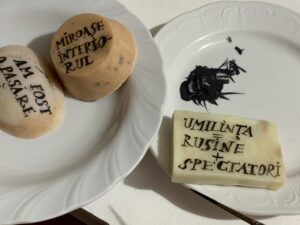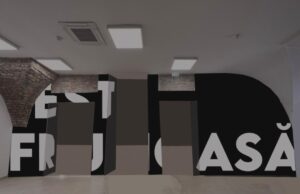Contrasens Cultural Association presents a new project with a social stake, entitled On Her Side and curated by Dana Sarmeș and Simona Constantin. The project is an interdisciplinary approach that deals with issues such as violence, aggression and women abuse, having several components: artistic research and production, an exhibition, and education through an extensive programme of mediation and documentation.
Ana Adam’s artistic intervention at the ON HER SIDE exhibition, entitled I see with my nipples, centres around recovering one’s inner strength and breaking free from self-victimisation, to which we are all tempted to surrender after the traumatic events that mark our existence. The artist creates an installation in the form of a participatory work consisting of soap bars she made herself, marked with poetic text inserts that address women’s frame of mind in abusive and traumatic situations.
Throughout European history, pain has not been a subject of philosophical investigation. It has been viewed only in relation to
Art is not born from nothing. It follows social structures. Art is not only about aesthetics, especially today. On the contrary, it has developed a complex relationship with the idea of beauty – but this is not what the following lines are about. Art is part of the substance of society, like a canvas soaked in ink and staring you straight in the face. And you can’t hide from that blue colour…
Lea Rasovszky’s art addresses subjects connected to the human being, her own feelings and experiences, the delicacy of feeling. Man, a significant source for her works, stands out through his power to overcome intense, traumatic moments by means of a superhuman power. The fragility of feelings hides a paradox of power. The absence or disappearance of something of yourself, whether physical or emotional, is replaced by a wholesome strangeness that helps you move on.
Contemporary artists often produce works that have an impact on the communities they come from or they want to address. In many cases, those who dedicate their art to the community use certain traits, customs, stories or specific traditions to create dialogues or build bridges between different groups. By such means, they can highlight problems, difficulties, and traumas, be they cultural, social, economic or moral. In times of crisis, art can be an engine of resilience. It is valuable at the heart of communities, as it has the ability to help the healing process.
If the term “gynocentrism” seems unfamiliar, it is because it cannot be found in any dictionary. It derives from two Greek words, “woman” and “bee sting”. It has been in use since 1897 and has a much softer meaning than its etymons. It was an ideological tool of the feminist movement of the 1870s. In the present context, gynocentrism is used to define, in short, a female perspective on the artistic world.
As a rule, a romantic relationship starts with a simple message: “You’re beautiful.” This is also the title of Suzana Dan’s work displayed at the On Her Side exhibition, an in situ intervention on the wall that provides the access to the Project Centre in Timișoara. Oversized, in block capitals, the seemingly harmless message was stuck on the wall, the artist having subsequently altered the surface of the paper with various materials.
Ioana Stanca is one of the new generation artists who break the barriers that separate artistic techniques. She is concerned not only with a less explored and under-represented space in the contemporary art world, but also an artistic expression popularly labelled as feminine. And she manages the impossible – to master both the craft and the concept.
There is a difference between face and surface. According to a study on domestic violence conducted by the National Agency for Equal Opportunities between Women and Men in the first semester of 2019, 38.94% of respondents stated that they suffered some form of domestic violence daily, while 20.57% suffered it weekly. Another study, carried out by the FILIA Centre in 2018, reported that 64.6% of respondents agreed that “a woman must follow her man” and only 20% of them would resort to some form of help to settle a domestic conflict.
I have noticed that in recent years, women still have been worryingly under-represented in cinema and when they are, they appear as contre-jour figures anchored in the fabric of a culture, often portraying stereotypical images that are easily recognizable to the general public and have no effect other than being aesthetically pleasing and “satisfying” the audience’s expectations.









